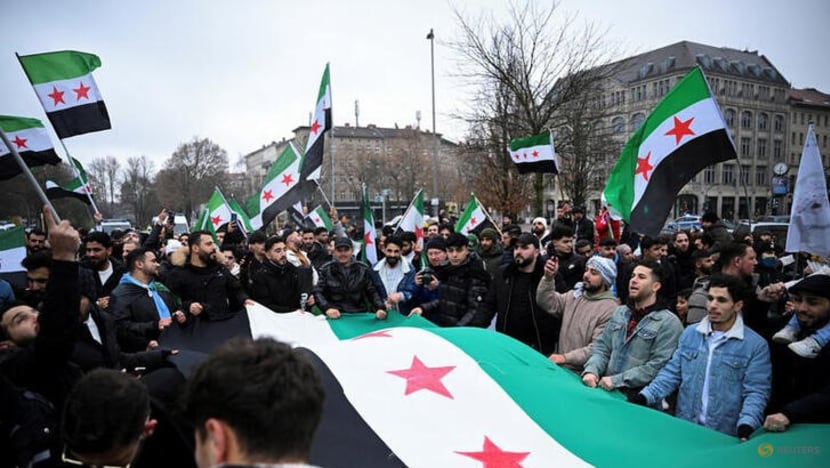Commentary: What Assad regime collapse in Syria means for Russia and Iran
That a popular armed insurrection toppled former president Bashar al-Assad in Syria has set off alarm bells in Moscow and Tehran, says RSIS’ James M Dorsey.

People carry a huge Syrian opposition flag as they gather at Oranienplatz square, after Syrian rebels announced that they have ousted Syria's Bashar al-Assad, in Berlin, Germany December 8, 2024. REUTERS/Annegret Hilse

This audio is generated by an AI tool.
SINGAPORE: No doubt policymakers in Tehran and Moscow are asking who lost Syria. In a tectonic rewrite of the Middle East’s geopolitical map, Bashar al-Assad was ousted on Sunday (Dec 8) after 24 years as president, leaving his principal backers struggling to limit their losses.
Russian President Vladimir Putin sought to preempt the debate by firing Sergei Kisel, the commander of Russian forces in Syria, a week earlier – as soon as the rebels captured Aleppo, Syria’s second-largest city. The Kremlin has since confirmed that Putin personally decided to grant asylum to Assad and his family, who fled the capital Damascus for Moscow.
Similarly, Iran quickly contacted the new rebel leadership to prevent what one official described as “a hostile trajectory" between the two countries. Iran’s state television said Hayat Tahrir al-Sham, the largest, best-armed rebel group, had guaranteed there would be no disturbance to the Sayyida Zeinab and Sayyida Ruqayya Shiite Muslim shrines in Damascus.
"The main concern for Iran is whether Assad's successor will push Syria away from Tehran's orbit,” said a second Iranian official.
The end of Assad’s reign is an existential threat to Iran, less so to Russia. That was evident in the contrast between the ransacking of the Iranian embassy in Damascus and the calm around Russia's Hmeimim air base and Tartus naval facility.
RUSSIA MAKES THE BEST OF A BAD SITUATION
Assad’s toppling will probably deprive Moscow of its two foremost military bases in the Middle East and the eastern Mediterranean and undermine its positioning as a major regional powerbroker.
"What Tartus meant for Russia was the ability to project maritime power and political influence relatively uncontested in the Middle East and allowed it to punch above its weight," wrote retired Belgian naval officer Fredrik Van Lokeren.
Leased to Moscow for 49 years in return for military assistance in 2015 during the Syrian civil war, the bases also allowed Russia to use Syria as a transit hub for Russian mercenaries operating in Africa.
As Assad arrived in Moscow, Russian state television announced that the rebels had guaranteed the security of the military bases – from which Russian aircraft attacked as they advanced towards Damascus – and diplomatic missions in Syria. The rebel assurances helped soften the blow to Russian prestige.
Russia can claim that it stuck by its friends while ensuring that the former president would be limited in his ability to attempt a comeback.
In return, state-run Russian media have changed their tone. The press stopped describing the rebels as "terrorists", referring to them instead as the "armed opposition that has taken power in Syria". The Syrian embassy in Moscow raised the opposition flag even as Assad set foot on Russian soil.
HIGHER EXISTENTIAL STAKES FOR IRAN
The stakes are much higher for Iran. One of the three pillars in its defence strategy is now crippled.
Lacking an air force and navy of any repute because of decades of United States and United Nations economic sanctions, Iranian defence relied on Syria and an alliance of non-state actors – dubbed the Axis of Resistance – for its forward defence, alongside the development of ballistic missiles and nuclear programme.
The ousting of Assad and the weakening of Lebanon’s Hezbollah militia – which reached a recent ceasefire agreement with Israel just weeks ago – have all but neutralised the alliance’s deterrence element along two of Israel’s borders.
Even starker, the alliance could have turned from asset into liability. Iran-backed Iraqi politicians and militia officials rejected Iranian Foreign Minister Abbas Araghchi’s request that they send reinforcements to Syria in support of Assad.
Iran and its allies will no longer be able to maintain a military presence in Syria or use the country as a support hub for Hezbollah. It will be forced to revisit its strategy and broader regional policies.
FEARS OF A POPULAR UPRISING
The fact that a popular armed insurrection toppled Assad has set off alarm bells in Moscow and Tehran.
Russia has long viewed popular revolts in Ukraine and other East European nations as US-engineered efforts to destabilise Russia’s neighbourhood, while Iranians have repeatedly taken to the streets in mass anti-government protests over the years.
“The situation in the Islamic Republic is not comparable to Syria at all. Nevertheless, one should take note of public opinion,” said conservative politician and journalist Naser Imani to an Iranian media outlet.
Critics removed without explanation social media postings in which they asserted that Iran had wasted resources on supporting an unpopular leader in Syria, an implicit criticism of Supreme Leader Ali Khamenei, a friend and staunch supporter of Assad.
Even so, some fear that the collapse of the Assad regime could strengthen the hand of the Islamic Revolutionary Guard Corps (IRGC) and its hardline supporters. IRGC members asserted that "abandoning" Assad constituted a "betrayal" that would have serious consequences for Iran.
Kasra Aarabi, a Washington-based anti-Iranian activist, quoted a younger IRGC member as saying: “We zealous youth will not forget the cowardice of the decision-makers.”
For Russia and Iran, the silver lining is that Hayat Tahrir al-Sham appears more interested in focusing on Syria’s rehabilitation and reconstruction rather than retaliation. In doing so, the rebels may help Assad’s backers save face while taking out one of their foremost regional assets.
Dr James M Dorsey is an Adjunct Senior Fellow at Nanyang Technological University’s S Rajaratnam School of International Studies, and the author of the syndicated column and podcast, The Turbulent World with James M Dorsey.

















